Ian Bull's Blog, page 4
January 23, 2014
John Dobson Blew My Mind
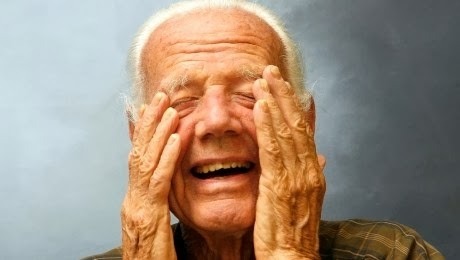
John Dobson died in Burbank last week, and when I read his obituary in the Los Angeles Times, I remembered him as the first person to stun me with the size of the universe. My brief encounter with him changed the way I see the world, influenced what I studied at university, and it still affects me to this day. Dobson founded the Sidewalk Astronomers in San Francisco, an amateur group of astronomers who built homemade reflective telescopes out of whatever they could find, including gigantic cardboard shipping tubes, metal rings, and discarded timber.

I saw the planet Saturn for the first time through a Dobsonian telescope that was painted with whorls of bright colors, on the roof the California Academy of Sciences in San Francisco. John Dobson himself was hosting the viewing party, and I was twelve years old.

I was interested in the cosmos, so my parents signed us up for a mid-winter, mid-week astronomy class. Every Wednesday we’d get in the car and drive into Golden Gate Park and attend a lecture at the California Academy of Sciences, in the Morrison Planetarium. It’s a round theater with a raised platform in the middle, on which stands a star projector, which recreates the stars of the night sky on the domed ceiling above you. The professor would speak -- This is what the stars in the Northern Hemisphere look like on the first day of summer... -- And the machine would whir and click into place and project the exact array of stars in the sky for that night. I would stare at the mechanical marvel in front of me, and then stare at the projected stars above me, amazed by both. To this day, I still remember how to find the visible planets in the night sky, and I know some of the secrets hidden in the constellations, like the middle star in the three star dagger that hangs from Orion the Hunter’s Belt is actually the Crab Nebula. On one moonless Wednesday night, the professor invited us to climb to the roof of the Academy building, where the Sidewalk Astronomers had set up a 12-foot long reflective telescope pointed at Saturn. I loved that we were allowed up there on the tar and gravel, and I could see over a mile in every direction. I remember that there were several astronomers up there, including Mr. Dobson himself. He was a tall and lanky guy with glasses and long brown hair, sort of a tall hippie version of Bill Gates.

It was finally my turn to put my eye up to the lens. When I looked inside I saw the planet Saturn, floating perfectly in black space. It looked like a Kodachrome slide from science class, it looked so perfect. As I looked in the lens, it seemed to be about as big as my thumb. The planet and its rings were mostly black and white but there was yellow and brown mixed in, and it was in sharp focus, and I could actually see the separate rings. I was convinced it was a trick, and that the man had just stuck slide behind the lens somehow. This is an approximate recreation of my conversation with Dobson, from several decades ago: Is that really Saturn? Yes, it’s really Saturn. It looks like a picture. It’s so clear. It’s a clear dark night, and earth’s orbit is fairly close to Saturn’s right now. How close is that? About 900 million miles. How far is 900 million miles? I’ll show you. Dobson then gestured for my parents and I to follow him close to the edge of the building, which was about 600 feet long. Imagine that the sun is a ball about a foot in diameter, which is a little bit bigger than a basketball, and we put it on the edge of the building. The earth is about 100 feet away from that basketball, so that’s about 30 steps for me. My dad, my mom, and I then followed John Dobson as he walked his 30 steps, and we were about 100 feet away the edge, and about a fifth of the length of the entire building. John Dobson held up his fingers and made a pinching motion in front of us. This distance is about the radius of earth’s orbit, about 93 million miles, and our Earth is smaller than a pea. We were so stunned, that we could only giggle. He then pointed off into the distance, past the building, and towards the dark trees of Golden Gate Park. Saturn is about ten times further away, which is almost twice the length of this building. It’d be in those trees over there, and it’s the size of a small plum. At this point, I was beyond words. I stared into the trees in the distance, imagining an orbiting plum out there somewhere. It didn’t seem conceivable that a plum would feel the tug of gravity and orbit a basketball a thousand feet away. Even more mysterious is how we, on our pea, could even see that plum. I think he saw that he was blowing my mind, and he smiled and then launched me into infinity. And guess how far away the nearest star, Alpha Centari, is? I shrugged. It’s a beach ball in Japan. To this day, it’s hard to conceive of scale this way. When I read his obituary, I fondly remember that night on the roof when John Dobson exploded my mind.

To explode your own mind, check out this website, and enter in some numbers of your own to get a sense of the scale of the universe. It’s courtesy of the Exploratorium:
http://www.exploratorium.edu/ronh/solar_system/
I later learned that the distances between the atoms in our body (when you increase their electrons and nuclei to the size to plums and basketballs) are just as vast and empty. Go big or small, most of the universe is empty. Yet there are more cells in our bodies than in our own galaxy. They estimate we have 3.72 x 10(13) cells in our body (that’s 3,720,000,000,000,000 cells) and our galaxy has about 10 (12) stars. However, our universe as 10 (12) galaxies, maybe more. And if certain math and physics models are correct, there may be that many “universes” beyond our own. We may be part of a multi-verse. That’s a lot to think about, sitting on our tiny orbiting pea. Around the same time, I discovered what became another great influence on how I view the universe -- Monty Python. Life is silly, and the more you embrace that, the happier and wiser you will be. John Cleese and Michael Palin may be the absurdist comic geniuses behind some of their best writing, but the composer and lyricist for their best songs is Eric Idle. His Galaxy Song sums it up for me, and I have these words laminated and pinned to the bulletin board in my office at home. It’s a constant reminder of who I am, where I am, and how to put it all into perspective...like John Dobson first did for me when I was 12 years old. Thank you John Dobson. Your sidewalk astronomy lessons worked on me.
THE GALAXY SONG -- by Eric Idle and John Du Prez Just remember that you're standing on a planet that's evolvingAnd revolving at nine hundred miles an hour.That's orbiting at ninety miles a second, so it's reckoned,A sun that is the source of all our power.The sun, and you and me, and all the stars that we can see,Are moving at a million miles a day,In an outer spiral arm, at forty thousand miles an hour,Of a galaxy we call the Milky Way.
Our galaxy itself contains a hundred billion stars;It's a hundred thousand light-years side to side;It bulges in the middle sixteen thousand light-years thick,But out by us it's just three thousand light-years wide.We're thirty thousand light-years from Galactic Central Point,We go 'round every two hundred million years;And our galaxy itself is only one of millions of billionsIn this amazing and expanding universe.
The universe itself keeps on expanding and expanding,In all of the directions it can whiz;As fast as it can go, the speed of light, you know,Twelve million miles a minute and that's the fastest speed there is.So remember, when you're feeling very small and insecure,How amazingly unlikely is your birth;And pray that there's intelligent life somewhere out in space,'Cause there's bugger all down here on Earth!
Check out these two links on Mr. John Dobson:
http://www.latimes.com/obituaries/la-me-john-dobson-20140119,0,6483430.story#axzz2qzMLOj3c
http://www.universetoday.com/108150/j...
Published on January 23, 2014 15:25
January 17, 2014
I want to kill Augustina
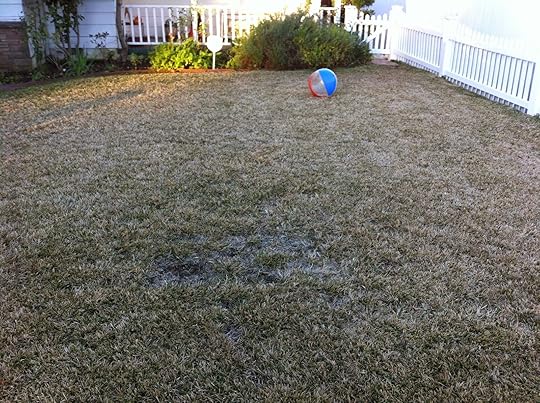
I hate my lawn. I call her Augustina. She’s a drunk. She’s ugly. She always needs something, always needs me to work on her, and then she never changes. She’s a St. Augustine turf, laid down in patches, some which never took in the shaded areas, and she turns half brown in winter. She’s like an old show girl with a tooth missing who forgets to dye her gray hair, and when you ask her to dance she stabs you in the bottom of your bare feet with a sprinkler head. She’s only eight years old and I’m plotting to kill her. All I have to do is turn her sprinklers off and let her...die. I’ve started to meditate on her murder. My wife Robin shrugs. She can be as brutal as me. “What is she good for? If she's a good-for-nothing, why keep her?” Lily, my daughter, loves the lawn, bare patches and all. I keep Augustina around for Lily, so she and her friends can do cartwheels and host dance contests, as they dodge the buried sprinkler heads. In most great crime stories of pre-meditated murder, the killer turns out to be a sap. In The Postman Always Rings Twice,when Frank and Cora set out to kill the Greek, you know that Frank is a dummy and will never get away with it. Yet, I love reading how these two craven fools screw everything up -- especially Frank. So as you read about me, plotting the perfect crime, feel free to laugh at me. I can take it, because I know what’s in your heart. If you’re like me, you’ve stood with your DWP bill in your hand and stared hard at your green mistress lying there. What? Does she think I’m made of money? I pay and pay...and you still look like crap. I get no respect. As I plan her demise, read and be entertained, but be warned. I may chart a path for you to eventually follow -- but there is a very good chance that killing Augustine may end up costing me a great deal. If that turns out to be the case, then consider this a cautionary tale, in serial installments. My neighborhood is perfect for a noir crime turf tale gone bad. Beneath the veneer of our white picket fences, there are termites eating away at the fence posts holding up this Southern California dream. The passing sirens in the middle of the night remind me that we are in a decaying American city. After all, we just qualified as a “Promise Zone” in President Obama’s war on poverty. I love that double-speak description of our plight. We live in a city of such promise! But that’s not what they mean. It’s sunny in the daytime, but life gets dark at night. That’s when I toss and turn and imagine her demise. In the mornings I walk outside to get the paper (I know, who still gets the paper?) and I stare at Augustine. What a thirsty ugly bitch. I see other men like myself, in robes and sweats, staring at their lawns, wondering why they pursued such fickle mistresses.

We know why. Vanity. Keeping up with the Joneses. A healthy lawn is some strange validation, twisted proof of my success. But she’s just a devil in a faded green dress, and I'm the putz who fell for her. I hear a hiss and look across the street, and I see a fountain of water erupt from a broken sprinkler head, and I see my neighbor Steve holding his skull and stomping up and down on the sidewalk in front of his house. He just put that new sprinkler system in last month. Then, there’s Hank, our new neighbor who just bought the new McMansion three houses down. The contractor flipped the house so quick that Hank bought it before the turf they rolled out even took root. Patches died after he moved in, so his lawn now looks like a chessboard. My affair with Augustine went south in early December, when I got our water bill. It and comes every two months in Los Angeles, and the water charges for October and December was $350 cheaper than it had been in previous months. At first I was proud of our little green household for saving so much! Granted, during the summer months we ran the hose to feed the double lane slip-and-slide for two hours straight every Saturday for Lily and the neighbor girls. Autumn itself creates a water savings, right? But $350 in savings seemed especially thrifty. Until I noticed Augustine. She seemed awfully brown and dry. I went to the front hall closet and discovered her watering system was unplugged. In October a handyman was fixing our fence and he needed to run an extension cord, and we had Halloween lights plugged in during October, and we dragged coats in and out of that front closet as the weather changed. During all this, the plug had either come out of the socket, or it had been pulled and never plugged back in. I figure she’d gone four weeks without water----six weeks, tops. Month after month after month for eight years, I watered her. Plucked her. Fussed over her. Worried over her bare spots in the dark corner that never gets sun. And then, in four fast weeks, she heads south. I started watering, hoping to bring her back from the brink. But it’s January, and nothing is going to grow. I have a choice...I keep watering, hoping she’ll come back in March when the Vernal Equinox brings Spring, or...I kill her. I can’t help thinking about the wasted money. $350 to water the front lawn, every two months. Without the watering, we conserve enough that our water usage is in Tier 1 billing. Water a lawn and you can jump into double and triple prices per gallon in Tiers 2 and 3. It can add up fast. That’s $1050 a year. That’s $8400 in just water since she was put in, and that doesn’t include gardening costs and fertilizer and winter grass costs. Then there’s my time, trying to repair her, nurture her...save her. I’m the co-dependent enabler who has been feeding this thirsty aqua-holic, and we’ve hit rock bottom. The only way I can save her is to burn even more cash in the hopes that she comes back. Then there is something else that is looming -- for all of us. The water reserves for Los Angeles are at 20% of normal, and we’re already a month into winter. The Los Angeles Times has an article today about the looming “mega-drought” is almost upon us, unless we get a miracle month of rain. I could water like crazy, and there’s a good chance we will be rationing by summer and she’ll die again anyway. And while all this is happening, the water prices are going up. I have some choices: I could put in a new lawn, but I’d have to water her just as much. I could put in a fake lawn --but that runs about $8000 for a good one, and I hear they get steamy hot in the summer and you get a gruesome rug burn if you slide or fall on them. Can I get away with letting her die? My worst fear is that I have a bare front yard that looks like it deserves a Chevy with no wheels up on cement blocks, and an inbred toothless banjo player in a rocker on the front porch. My second worse fear is getting lured into some artsy and creative vision that sucks ten thousand bucks from my pocket, and keeps sucking. Sunset Magazine is lurid pornography for homeowners, and like all pornography, it can create bizarre appetites that can never be satisfied in real life. Why am I worrying about this anyway? I should just plant a cactus garden in the front, and accept that we’re Arizona 2.0 in the making. Everywhere else in the country you grow your own grass. In Southern California, there are grass farms out in Oxnard where the fog and the nearby ocean keep the land cool enough to grow turf. We then cut it up and cart it into the San Fernando Valley where it’s 110 in September, and two days without water can kill any plant that’s left out in the sun. We’re insane. We’ll all be killing our lawns soon. I just have to be the brave one on our block and kill my Augustina first. I ‘ll get the broken down Chevy and the toothless banjo player next. I heard one rumor worth exploring -- that the DWP will pay me to kill my lawn and then help cart my dead turf away. But she has to be living. I can’t let her die, and then apply for the rebate and get the money. I have to lure her back from the brink enough to prove she’s still alive, and then we can kill Augustine together, and then they’ll give me money for my crime. It’s a little twisted, but I like having an accomplice, especially if I can get two bucks a square foot, which is for my lawn ends up being $3000. That’s a motive for murder. For now, I will water, and investigate my options. I will keep you posted, however, because I have crime on my mind.
Published on January 17, 2014 06:17
January 10, 2014
Crime in LA # 4 : My Daughter Helped Catch a Killer

When Lily was five years old and at school in Kindergarten, she and two classmates helped the police nab a suspect wanted for murder who was hiding from police. The neighborhood streets were blocked off, her school was locked down while helicopters circled overhead, and news cameras crews arrived in time to see the perp led away by police in handcuffs. A local CBS reporter then interviewed Lily and her two friends. In the three years since it happened, it has become a family story that we remember at least once a year, and Lily is already tired of it -- and maybe for good reason. I’m proud of how she and her friends behaved, but it’s not the lasting memory of Kindergarten you want your kid to have.
Lily was playing at recess in the sheltered Kindergarten play area, which is fenced off from the rest of the school in its own private corner. They have their own tricycles, balls, jump ropes, play structures and planter boxes, all behind fences covered with ivy and honeysuckle. In spring, when this incident happened, the kids had discovered how to pluck the honeysuckle flowers, and slowly pull out the long stamen from the bottom. If you do it just right, there’s a drop of honey tasting flower sap left on the stamen. It’s nature’s candy, which you can lick off.

All this made her Kindergarten feel private, safe, and even idyllic. When I entered the gate to their classrooms, there was always a gaggle of happy five-year-olds playing and learning. It fit my nostalgic view of what Kindergarten should be like. The only disadvantage to this private little “children’s garden” is that it butts up against apartment buildings on one side. Actually, It almostbutts up against the building, but not quite. The apartment building has a walkway alongside, and then there’s a high fence right on the property line. If you jump that fence from the apartment buildings, you’re in a fenced open-air corridor that is about four feet wide, with the ivy and honeysuckle covered fence that frames the kindergarten area in front of you. This corridor is sixty yards long; there are trees roots, storage bins and some loose gardening tools back there.


Lily was jumping rope with her friends on this fine spring day, and they noticed a man jump over the high fence from the apartment buildings, and he landed in this corridor between the fences. He immediately found a broom and started sweeping. They’d never seen him before, but he looked busy enough that they assumed he was a new janitor. Still, it was odd that he had jumped the fence like that. Then they noticed he had a gun in his front pocket. I can’t get more from Lily than that. Was the gun all the way in? What color was the gun? All she remembers is that it was a big gun, it didn’t fit all the way in his pocket, and that it was black. The man was wearing all black, so they didn’t see the gun at first, but he spent enough time sweeping back and forth on the other side of their fence that they spotted the pistol through the spaces in the ivy and honeysuckle. Or maybe they didn’t. Maybe they added the gun for dramatic effect, as children often do. There are enough posters of bad men with guns in our culture, that if a five year old describes seeing someone she thinks is a “bad guy,” she might throw a gun in to seal the deal. Lily and the others ran to their teacher and said, “Mrs. D, there’s a man with a gun on the others side of the fence!” Mrs. D. is an experienced teacher and a mother of two, and she has heard many invented dramatic stories of “bad guys” from children, and one of her jobs is to help them glean the truth -- but this was not such a teaching moment. There was already a helicopter-circling overhead, and when she called the principal, he was not in his office. “If you girls are lying, you will all be in big trouble with Mr. M.,” she said. “We’re not! We saw him jump over the fence!” That’s when Mrs. D. saw Mr. M. rushing across the asphalt of the main campus, holding a walkie-talkie, and everything lined up in her head. She rushed over to Mr. M., they spoke briefly, and then she rushed back and herded her kids back into the classroom, locked the doors and closed the blinds. The corridor runs right behind two Kindergarten classrooms, so although there are bars on the windows, he could have peered inside.

That’s when the lock-down began. Students and teachers were sealed in their rooms, and the school auto-dialed every parent and notified them that their children were safe, but to stay at home until notified. The news spread across the city. The neighborhood was blocked off as the SWAT teams moved in. TV news trucks and helicopters arrived and hovered on the perimeter and started broadcasting. Firefighters went from room to room, checking on the kids as they handed out bottle water and snacks. Another crisis happened in mid-lock down. One of Lily’s classmates has a severe peanut allergy, and some of the packaged cookies the firemen handed out had nut traces in it. She went into anaphylactic shock, and Mrs. D. had to call for the firefighters to come back. They stabbed her with an ephedrine pen, and they took her away in a paramedic ambulance. She had a double adventure that day, and was the only one who got to leave the school early. The suspect moved around on school grounds for a while, and then jumped back over the fences and went back into the apartment complex. That’s when the circling helicopters and the SWAT teams tightened their noose and grabbed him. It took several hours to search the apartments, the neighborhood, and the school to make sure there were no accomplices hiding, and then the police gradually opened up the streets again. By the time the police finally led the suspect out in handcuffs, CBS news was in place they got the video shot that aired during the 6 p.m. news report. The suspect was wanted in a gang-related double homicide that had happened six months prior, and he’d been living underground ever since, moving from place to place. An ex-girlfriend finally turned him in. Then the news interviews began. Some moms, including my wife Robin, insisted that during the interview the cameraman only shoot the young heroes from the knees down, so the kids could not be targeted by any of the suspect’s disgruntled fellow gang members. All you see are her silver shoes. Check it out:
http://losangeles.cbslocal.com/2011/04/15/authorities-searching-for-murder-suspect-in-studio-city/

The kids were supposed to be out of school for a half day at 1:30 p.m. that day, but they finally left campus at 5:30 p.m. The Kindergarten parents gathered in Bradley’s backyard for his late-starting birthday party and Spring Break kick-off. We stood around, drinking wine and beer and staring at our screaming kids, dazed, wondering what had happened to the world since we were in Kindergarten.
Published on January 10, 2014 12:28
January 3, 2014
TBI : The Invisible Injury for the Forgotten Generation

The last U.S. combat troops will leave Afghanistan in 2014, ending America’s longest war. The Iraq war ended in December in 2011, with an official flag-lowering ceremony in Baghdad, in which Defense Secretary Leon Panetta declared that a free, democratic Iraq was worth the sacrifice in American lives. What about the sacrifices made by those who did not die? What lingering injuries and disabilities will plague this generation of veterans? And will we be able to even see them? It’s easier to accept that an entire generation of soldiers is damaged when you can actually see the injuries on thousands of men and women around you. The cost of war surrounds us in our daily life. In the Civil War, amputation was the lingering disability. Doctors sawed off injured feet, legs, hands and arms, to prevent the spread of infection and gangrene that they did not yet understand. Years later, when you saw a man with a missing limb, you knew where he’d been and what had happened to him. In World War 1, soldiers met mustard gas. These gas attacks not only seared a man’s lungs, they could burn his face off. In the 1920‘s in Great Britain, there were tens of thousands of veterans with brutal facial injuries, and it was declared the “worst loss of all,” worse than any amputation, since it robbed the veteran of his identity and humanity. The first advances in plastic surgery happened because doctors created the first modern prosthetics to give these veterans their lives back. In later wars, the injuries soldiers suffered became less apparent. The dioxin in Agent Orange, first sprayed in Vietnam 50 years ago, has injured hundreds of thousands of Americans. Yet, you cannot pick out the veteran disabled by Agent Orange from the crowd. This invisibility may be one reason why the Agent Orange Registry estimates there are still 500,000 disputed disability claims related to Agent Orange with the Veterans Administration. And what about our current generation of veterans? There are over two million veterans from the Iraq and Afghanistan wars. What is their most common injury? We have all heard of Post Traumatic Stress Disorder, or PTSD. You do a keyword search for PTSD on the Los Angeles Times website, and dozens of articles come up about the disorder. Many feature articles have been written about veterans who can’t re-assimilate into American society. They may be overly anxious, easily frightened and quick to anger. They may have trouble holding jobs. They may be depressed, or feel an absence of emotion, so in order to feel anything they engage in risky behavior, like racing motorcycles at top speeds without a helmet, or they self-medicate with alcohol or drugs. Consider my own Uncle Ian, my mother’s brother, from whom I get my middle name. Once he returned home after being injured, he seemed to make a miraculous recovery. However, his personality gradually changed. He became more of a thrill seeker. He often had accidents -- car accidents, work accidents, sporting accidents. He was kind and loving, but sometimes he was inexplicably quick to anger. After one argument he went out on his snowmobile on a frozen lake and was speeding so fast that he flipped it tail over end and it landed on him, crushing his pelvis. Another time, he was helping a friend build a house and he climbed far too high on the scaffolding without a safety harness. The scaffolding collapsed and he fell and shattered his leg. He suffered from depression and anxiety, and compounded with the pain from his injuries, he finally committed suicide. It wasn’t until I read about veterans with PTSD did I recognize his behavior and realize it had a name. The only problem is, my Uncle Ian never saw combat. He never even served in the Armed Forces. He had something else that often leads to PTSD. He had TBI, or Traumatic Brain Injury, from a snow sledding accident at age 15. My mother’s family lived in cold Port Arthur, Ontario, Canada, a small town that grew into what is now called Thunder Bay. My uncle Ian was sledding on a steep and icy hill, when he climbed higher than the other boys for a more thrilling ride. His sled jumped the snow bank at the end of the run, and he flew into traffic. A car couldn’t stop in time, and its bumper slammed into his head. He was in a coma for over two weeks. He made what seemed to be a miraculous recovery, and had no memory of the incident. His challenges didn’t start until months later, and I don’t think anyone ever linked his changed behavior as an adult to the TBI he suffered as a teenager. If he had lost a leg, or had his face burned off, we would have always remembered that he had been injured. The invisibility of his injury made forget that it was (I believe) the root cause of many of his problems. He did receive some rehab at the time, but once he appeared to speak and walk normally, everyone assumed that his recovery was complete. In fact, much more rehab probably needed to be done.

New studies are showing that our newest disabled veterans are not just suffering from the “stress” of PTSD. In many cases -- perhaps in most cases -- they actually have an injury, like my uncle - TBI -- Traumatic Brain Injury. It’s the TBI that’s causing the stress problems, and the PTSD is the name we give what we see. This, from both the Los Angeles Times (Dec. 3, 2013) the on-line University of California News Room (Dec. 11, 2013): In a novel study of U.S. Marines investigating the association between traumatic brain injury (TBI) and the risk of post-traumatic stress disorder (PTSD) over time, a team of scientists led by researchers from the Veterans Affairs San Diego Healthcare System and University of California, San Diego School of Medicine report that TBIs suffered during active-duty deployment to Iraq and Afghanistan were the greatest predictor for subsequent PTSD. What are the symptoms and behaviors of PTSD? vs TBI? Let’s compare and contrast. These are the symptoms of PTSD, taken fromMaketheconnection.net, which is a PTSD support group:1 Having nightmares, vivid memories, or flashbacks of the event that make you feel like it’s happening all over again2 Feeling emotionally cut off from others3 Feeling numb or losing interest in things you used to care about4 Becoming depressed5 Thinking that you are always in danger6 Feeling anxious, jittery, or irritated7 Experiencing a sense of panic that something bad is about to happen8 Having difficulty sleeping9 Having trouble keeping your mind on one thing10 Having a hard time relating to and getting along with your spouse, family, or friends
Now, here are some of the symptoms of general TBI -- and not TBI related to combat. These are general symptoms of Traumatic Brain Injury. Blows to the head from falls, car accidents, getting popped with a baseball or a bat, or getting multiple concussions playing football. It also can happen from a lack of oxygen, from asphyxiation during choking, and near drownings. These signs and symptoms may appear immediately, or weeks after the traumatic event. These are taken from the Mayo Clinic, at www.mayoclinic.com. Moderate brain injuryThe signs and symptoms of mild to moderate traumatic brain injury may include:11 Memory or concentration problems12 Mood changes or mood swings13 Feeling depressed or anxious14 Fatigue or drowsiness15 Difficulty sleeping16 Sleeping more than usual17 Agitation, combativeness or other unusual behavior
What caused the TBI? While the Vietnam War had Agent Orange, the conflicts in Afghanistan and Iraq had the infamous Improvised Explosion Device, or IED, which caused 1/3 of all casualties in Iraq. Imagine explosions going off right next to your head, or the shock waves the rolls through an armored Humvee after it drives over a bomb. That sloshes the grey jello inside your skull that we call brain matter. The numbers are still out, however, about how many veterans had bombs go off near their heads. I believe that the number may be very high, and that PTSD may turn out to be, in fact, a bi-product of TBI. Why is the distinction important? Because it changes our approach to how we view them, and how we treat them. How do we handle a basketball player who endures a traumatic emotional event that prevents him from playing? We may send him to a psychiatrist or psychologist. We may even prescribe anti-depressants. We hope he overcomes his stress and gets back in the game as soon as possible. Ultimately, he is the one responsible for his recovery. What if he is injured? If he rips his Achilles tendon and he is weeping in pain, or is angry, we don’t call his tears an emotional problem. We see it an an injury first. One of the challenges of TBI is that it’s hard to know when a certain behavior is a symptom. A person with TBI may lose memory and cognitive skills, but still insist they are “back to normal.” They may have trouble reading, and balancing a checkbook, yet not recognize the extent of their own problem. Let’s mention just two parts of the brain, that will create new and different behaviors in people if they are damaged. The amygdala is an almond shaped organ near the front of the brain that processes memory and emotion. You could call it the “ fear center,” because it reminds you of what is terrifying and when you should fight or flee. The frontal lobes are where we process information and make the executive decisions to get through our day. They also help us to control our impulses. Why is the veteran terrified when a car honks? It may not be just leftover stress he must work through. His damaged amygdala may be hypersensitive and recalling a minor stimulus as a terrible threat. What about the angry veteran who fights with his wife and then jumps on a motorcycle and tears off into traffic? He may need more than counseling. He may have a frontal lobe injury that can’t process choice and conflict well, and he can’t control his impulses. If it jumps to amygdala interprets an argument about the rent check as a life and death threat. These same reactions can be created in the laboratory, with lab rats. In 2012, Dr. Maxine Reger from UCLA was able to create PTSD symptoms in rats by damaging their amygdalas by giving them concussions. There are 2 million veterans from the Iraq and Afghan wars. Tens of thousands may have TBI and PTSD. How do we treat them? We must convince them they are injured, and then test for what specific injuries they have. Once we know their injuries, we don’t force them to do what they cannot do, because that exacerbates the problem. Instead, you remember they are injured and develop compensatory strategies to get through life. After you have your compensatory strategies in place, then also work on a fixing the injury itself. Consider the injured basketball player. You convince him to stop playing, even if he insists he can play through the pain. He gets tested. Is it a pull, or a ripped tendon? Once you know, you then give him compensatory strategies -- like crutches, or a bandage. Then you work on fixing the injury, with surgery and rehab. Some brain injuries can’t be cured. If a section of the brain is gone, it’s gone and won’t come back, just like the basketball player who loses a foot. But the brain can rewire itself. As long as we live and breathe, the brain can create new connections, at any age. Neuroplasticity -- the brains ability to adapt and change and rewire itself to face new challenges and stimulus -- is where the answer lies. Donald Hebb first said in 1949, that “cells that fire together, wire together.” There are exercises for kids with TBI, dyslexia, visual processing problems, even autism, and these exercises force the brain to operate globally to solve challenges that one section of the brain can’t handle. For instance, when you are calling long distance, the phone connection will sometimes use three different satellites if it can’t make the connection with the satellite that is closest. The brain will work in the same way, if you encourage it to make the new roundabout connection. One of the most famous rehab “work arounds” after brain trauma was with Congresswoman Gabrielle Giffords, as she was recovering from gunshot wounds to her brain. She couldn’t say her name -- but she could sing it. Music works a different part of the brain than speech, and she learned to speak again by running the connection through the music part of her brain. There is another overall strategy for TBI and PTSD that is already working, and the Armed Forces have been using it for years -- Meditation. Some call it Transcendental Meditation, some call it by it’s new buzz word, “Mindfulness.” Enter these keywords into any search engine, and see what pops up: Meditation, TM, mindfulness, PTSD, TBI, Marines, Army. Since 2010, the Marines and the Army have found that meditation works for their veterans with PTSD and TBI. Enter just the keywords “meditation” and “TBI” and there are just as many articles about how meditation works to help the brain rewire itself after any kind of TBI injury, not just those in combat. I worry that there will be a generation of injured veterans who are angry, depressed, and addicted, and we will dismiss them -- There goes another angry vet speeding on a motorcycle after a bar fight because he doesn’t know the war is over. We have to recognize their changed behavior for what it actually is -- TBI which requires rehab work, and not just counseling and medication. Rehab also costs, money, but it costs much less money in the long run because it doesn’t involve constant medical visits and medicine, and it can specific and targeted. And TBI will create much higher cost to society if it remains untreated.RESOURCES:For resources on how to recover and rehab after brain injury, check out the Brain Injury Association of California: http://biacal.orgThe article about the rats is: "Concussive Brain Injury Enhances Fear Learning and Excitatory Processes in the Amygdala" by Maxine L. Reger, Andrew M. Poulos, Floyd Buen, Christopher C. Giza, David A. Hovda, and Michael S. Fanselow Biological Psychiatry, Volume 71, Issue 4 (February 15, 2012), published by Elsevier.Amygdala: An almond-shaped cluster of neurons in the limbic system thought to be involved in processing emotions and memory.Frontal lobes: Area of the brain made up by the front portions of right and left hemispheres of the cerebral cortex. These areas are involved in memory, planning, organization, language and impulse control. These areas also have been linked to personality.
Published on January 03, 2014 15:47
December 28, 2013
California Winter Fashion

This week, the Winter Solstice marks a special point in our planet’s yearly voyage around the sun. Our planet does not spin straight up and down, in comparison to the gigantic ball of fire we orbit. We actually tilt -- 23.5 degrees, to be exact. We are like a spinning top that’s always leaning to the same side. The degree and direction of that tilt stays the same no matter where we are in our yearly journey. On December 21st, our northern hemisphere is tilted from the sun---the farthest away it will be all year, and the southern hemisphere is the closest. If the Earth were a leaning drunk man, on December 21st our tipsy planet has his head out in cold space, with his butt against the fire. On June 21st, it’s the opposite: his scalp burns while his toes are getting frozen. This tilt creates our planetary seasons, which are always opposite to each other in the two hemispheres. Cold winter in the Northern Hemisphere, warm summer in the South, and the Tropics in between have seasons too, but a little less extreme. That means that today in Maine they’re wearing parkas, snowshoes and ear muffs and tapping maple trees. In Sydney, Australia they’re in board shorts and bikinis drinking beer on sailboats or surfing on Bondi beach. But in California, the seasons don’t match up easily with the rest of the world, despite the Golden State being well above the Tropics. That means we can’t figure out how we’re supposed to dress.
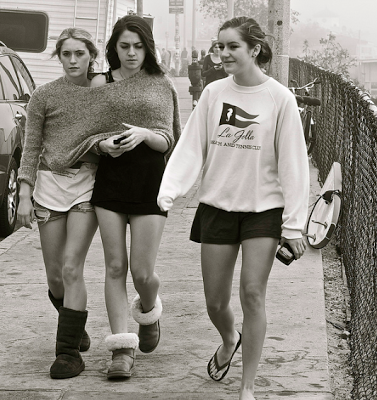
At 8:30 in the morning in Southern California, you’ll see a woman in a long winter overcoat with a chic scarf standing on a street corner next to a man in flip flops, board shorts and a T-shirt, waiting for the light to change. The man is shivering a little, but he’s committed to proving he can live like a surfer all year long. The woman is maybe a tad too warm and sweating under the collar, but she’s committed to wearing her fashionable winter clothes at least a few weeks out of the year. It’s warm in the sun and cool in the shade, so you’ll see the board short folks sticking to the sunny side of the street, while those seeking a winter wonderland will be hugging the buildings, searching for shadows. You also see mad fashion mash-ups that you get nowhere else in the world. Plenty of women wear their down parkas up top, and then flip-flops down below. Guys will wear cargo shorts with a ski sweater. Both men and women will wear knit caps with their arms, legs, and digits exposed. We sometimes export these bizarre trends, and people copy us without realizing that we have a seasonal disorder. Consider the woman wearing a thigh-exposing denim mini-shirt, and then oven-hot Ugg Boots on her feet. That weird look came from our seasonal confusion, folks, not any true fashion sense, so be wary of copying us.
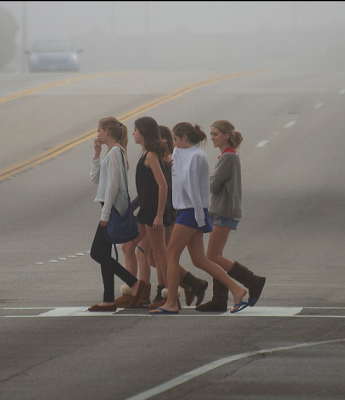
It’s a coastal issue, mostly. When you get into the San Joaquin Valley and then closer to the Sierra Nevada mountain range, our behavior matches the rest of the country. True, you’ll sometimes see people skiing in bikinis (only in California), but generally people dress appropriately. A Visalia cotton farmer wears thick denim in winter, and woman working for the Forest Service in Truckee knows to wear snow boots in Winter. But if you cross the coastal range and get closer to the ocean, the temperate effects of the ocean confuse us.

In San Diego, it’s not that bad. San Diego has the best weather in the country, which means it’s 85 in the summer and 70 in the winter, and only the absence or presence of leaves on the trees will tell you whether it’s winter or not.

When you get to Los Angeles, the confusion begins. Los Angeles is a semi-tropical desert, which means it can get warm in winter, but the warmth doesn’t stick around. It’s cold at night and in the morning, enough for frost to happen, but then it can be 80 degrees in the middle of the day if you’re standing in the sun. It’s hard to know what to wear, so we invent bizarre clothing combinations as we each decide which trade-off we prefer, shivering or sweating. The amount of cement in the urban sprawl only makes it worse. Cement and asphalt don’t hold heat well, so it rises away quickly at night and reflects into your skin during the day.

As you get to Northern California, the weather stabilizes, but in ways that don’t match the rest of the country. In winter, Monterey and San Francisco have brilliant days of blue skies and bright sunshine, but it’s still too cool to strip down. In summer, the interior valleys get so hot that the rising air sucks in air from the coast to replace it, and that cooler ocean air hits the coast and turns into fog -- fast moving, bone chilling, wet fog. The last thing you want to do in summer in either Monterey or San Francisco is to go to the beach and take off your clothes. You’d get hypothermia.
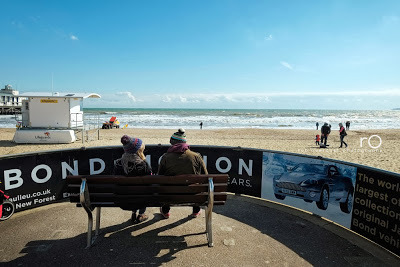
We want our summer and winter experiences to match the rest of the country, so we engage in wishful thinking and questionable behavior. In San Francisco, in winter time, if the sun is out and you can get out of the wind, you can actually find warmth. You can find guys in the parks with their shirts off and women in bikinis and shorts lying on beach towels, but laying low behind hedges. If you’re lying flat to the earth the sun will feel like it’s 80 degrees, but if you raise your head above the hedge row the cool breeze will chill you. That’s why you see people in swim suits wearing down parkas on top -- they’re on a search for a heat sink in which they can rest, and pretend it’s summer in the middle of winter. In summer, it’s the opposite. In most of the city the wet fog is moving so fast that it’s better to wear a winter raincoat than any kind of summer clothes. But Northern Californians still try to be like the rest of the country. That’s why they’re wearing down parkas on July 4th as they barbecue in their tiny backyards, and then they all go down to Crissy Field by the Golden Gate Bridge, and watch the fireworks over the water change the color of the thick clouds while the fog horns blast.

A trip to the beach is always wistful in Northern California. If it’s warm, it’s still not warm enough to go swimming. If it’s cold, it’s wet enough that you want to be in the car. Farther north, the Coastal Redwoods take over and they create their own eco-system. It’s a temperate rain forest; wet in winter, less wet in summer.
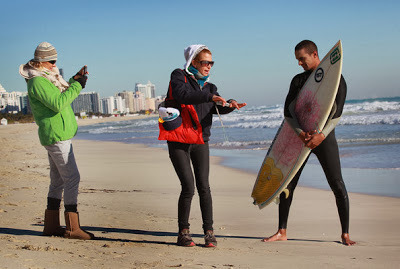
As winter takes over in Southern California, I plan to enjoy the next six weeks. There was frost on the ground on the first day of winter, but the forecast for later in the week is eighty degrees. January has the best weather of any month, which is the whole point of the Rose Bowl Parade. Look America! While you’re freezing, we have a hundred floats covered with roses and tropical flowers, and it’s brilliant sunshine! Come move West! The weather is great for hiking, and you can get a sun burned face if you’re not wearing a hat. In February it all changes as the rains finally come, and then we’ll remember that it’s winter and we’re supposed to cover up, but for the next six weeks it’s glorious, as long as you accept the wackiness. Our changing climate will mean winters will get more wet and blustery and summer will be hotter and drier, but for now, winter means I can wear my ski sweater with my swim trunks and flip flops.
Published on December 28, 2013 14:37
December 19, 2013
The Super Aggressive Christmas Performance

The Christmas season has zones of anger, aggression, disappointment, and fear. The zones are the crowded places -- the shopping centers, parking lots, post office lines and grocery stores where people must go in their obligatory quest for joy. Get to the store early to purchase your joy, wait in line for your joy, make sure you bring home joy for your family, and be joyful on command while doing it. Time, space and resources are limited, so we end up jockeying against each other in our individual quests for joy, and it can sour a crowd quickly. I can dodge most zones by planning ahead and avoiding people. But there’s one zone I must enter each year, and it always scares me: the school auditorium for the Christmas Singing Performance. Lily is in third grade, so this year is my fourth visit. Although it scares me, I’m battle-hardened. Like fathers everywhere, I know my job on this day and I prep for it with grim determination. I get up early, charge the camera battery, make sure I have the long lens, and I’m wearing the right gear. Robin and Lily are also up early, perfecting Lily’s long hair and steaming the wrinkles out of the outfit for the performance. They’re the show, I’m logistics. I leave first, with one of Robin’s long scarves. It will be a seat holder. School is close enough that I could walk, but today time is crucial, so I’m driving. My job is simple; to secure two good seats in the auditorium and hold them while Robin gets Lily to class, and then she can cross campus and get to her seat before the show starts at 8:15 a.m. I see other neighborhood cars with solitary drivers and I know they’re like me. They’re the early planners, those people who decide they want to be the first ones in. There’s a line at 7:45 for the three hundred seat auditorium, and there’s already a line of eighty people waiting, most of them with tripods and camera bags. People smile and trade pleasantries, but we’re like photographers ready to enter the Olympic Stadium on the day of the 100-meter dash finals. We’re colleagues, but we all want that one special spot. We’re also of like mind; if we plan ahead and work hard, we can grab seats and insure joy for ourselves and our family before anyone else arrives. The doors open at 7:50, and the first battle begins. Some people are bold and come with six or seven sweaters or scarves and lay them down and fill a row. The best way to hold them is to plop down in the middle seat, get on your cell phone and keep saying, “these seats are taken, these seats are taken,” to anyone who dares approach. Some make the mistake of putting down several sweaters or jackets, and then leaving. Their “reserved” spots will disappear, and once they return and find five people sitting in their spots, they’ll be lucky if they can shame even one person to give his or her seat up. I understand the pressure. Grandparents and aunts and uncles are in town, they move slow, they want to see the snowman collage that Class 34 made, and then linger to talk to the children as they prep for the show. That’s where the excitement is, and why they came to school today. They’ll get to the theater when they can. We, the brave few who breach those auditorium doors first----know what our jobs are.If we don’t hold the required number of seats, we will have failed in our jobs to ensure Christmas joy for our families. We also know that there aren’t enough seats for everyone who wants to see the show, so we set up our perimeters and guard them. Then there are the video and camera people. They fight for their position in row four and back, they get their cameras set and they raise up those tripods. They’re gambling; by grabbing the less desirable seats, they figure they can occupy more real estate without too much of a fight. But if you’re in row four or back, you know that the video you are shooting will be too unstable in the close-up, so you need that tripod, damn it, or there will be shaky video to show on Christmas night. By 8:00 a.m., there’s a forest of tripods back there.
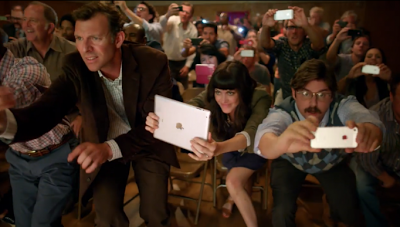
I grab two seats in row four, and set down Robin’s scarf to save her seat. I set up my own camera, with no tripod. Instead, I’m wearing my thick jacket, because I can rest my padded elbow on the wooden arm chair and create my own comfortable “mono-pod,” and shoot a steady image. I’ll overheat, but I don’ care. I have to lean into Robin or my neighbor to get my shot, but I’m ready. Tap on my shoulder all you want, tripod boy. I’m doing my lean, and I’m not moving. At 8 a.m. the second jockeying battle begins. We early settlers, once competitors, now must fight and defend our territories against the interlopers who arrive on-time. We were the busy ants who planned ahead, and now in come the fiddling grasshoppers, only fifteen minutes before the performance, and they’re amazed there are no seats left. Is this your first year, buddy? I feel for you, but we’re taking care of our own right now. The comments between 8:00 and 8:10 a.m. get aggressive. There are too many people trying to sit in too many guarded seats, and the mom guarding six spots can’t hide in her cell phone anymore, and the dad with the tripod up too high ends up raising his voice as well. The newcomers plead for fairness, and often get rejected. “Yeah, and Merry Christmas to you too,” often gets said, a few decibels too high and dripping with disdain.
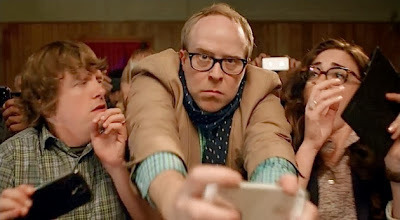
Robin arrives, along with the other moms and dads. People find their seats, or take a spot standing at the back of the auditorium, leaning against a wall. I know the feeling, that’s where I spent my first year. But there is one more battle. There is a final wave of twenty people who tumble in at 8:14, just before the kids march in. These people are joyful without effort, laughing and waving, and clueless to the unwritten rules of How to Properly Secure Seats for the Grammar School Auditorium Performance. They sit anywhere, right on the hands of the people trying to guard the chairs, ignoring the pounding on their shoulder, while they wave to the other Room Mom six rows back. Or they plop down in the aisles, ignoring the fire codes, or they sit right on the floor in front in front of the stage and yank out their tripods and cameras. They missed a chance for the best seat? These self-appointed VIPs create their own. They also stand their ground, and their behavior is so audacious few people challenge them. Although a murmur of dissatisfaction rolls through the rows, we all just want the bickering to end and the show to start. Then the principal comes in and grabs the microphone and calms the collective savage beast. Like that poster that reminds us that everything we need to know in life we learned in Kindergarten, the principal turns the first minute of the performance into a gracious thank you to all the parents for coming, and then gives us all a gentle reminder about how and where we sit, why rules are important, and how he’s proud of us for being such good role models for our children. The murmuring goes down, the aisles clear, and the music begins.
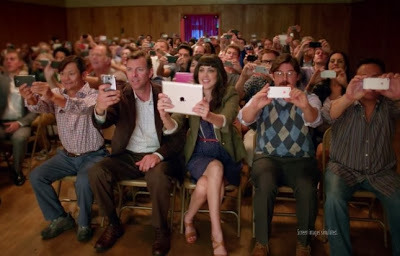
And everything changes when the kids come in. Time stops, and we all get our moment of joy, watching our children and their classmates mount the risers and then turn to face us. They peer out into the darkness and then their eyes brighten and they smile and wave when they spot us. They are all dressed up and proud of their work, and they feel safe and loved because they know we are there watching and caring about them. There’s an empty seat next to me, and the father sitting on the other side alternates between guarding it with his hand and madly texting into his phone. A woman comes in late after pounding on the door, and she makes her way to row 4, and we all go into the half-crouch as she squeezes past us. She collapses into her spare seat, closes her eyes and exhales. There was another child to drop off at another school, but she promised that she would get there and see the performance, and the dad promised that he’d help make it happen -- and she made it, on a day when the world conspired against her. I glanced over and saw her eyes brighten when her child hit the stage, and she waved at her daughter just like I did with mine. Their child spotted her and smiled like the Cheshire Cat, beaming light right back at them. Parenting is showing up, and Mom and dad had made it happen. They’d done well. The performance was great. Some classes sang in two part harmonies, and in repeating rounds, which isn’t easy, They weren’t just belting it out, they’d rehearsed, and it came out as sweet music. Seventy-five third graders sang as one, which turned all 350 of us in the audience into one, and we embraced the moment. My fear turns to pleasure on a dime, and I realize both feelings are in my mind, not in the seats or in the people around me. Everything I experienced before was, and is, all in my head. I suddenly feel regret within my pleasure; she finishes at this school in two years, so there are only two of these performances left. I feel the days and the months racing past, and I need more moments to embrace. I get a grip and return to the present moment, listen to the music and relax. The children give us all the Christmas joy for which we’d come, and I receive it, with thanks. I am grateful for all I have. Merry Christmas.
Published on December 19, 2013 11:28
December 12, 2013
When will the dying begin?
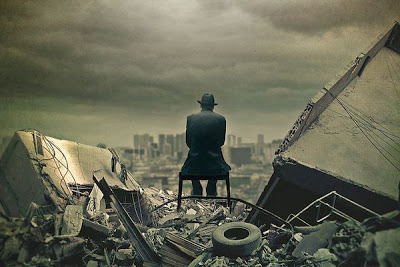
When will the dying begin? I put it at less than ten years. Hundreds of thousands, maybe millions, will die in some kind of environmental disaster. It could happen anywhere. From the Los Angeles Times -- A National Research Council Report says that “the planet is warming so quickly that the world should expect abrupt and unpredictable consequences in a matter of years or a few decades.” The summer fires and the winter storms that disrupt our lives, destroy homes and businesses and cost so much? And the hurricanes? And the droughts? It’s going to get worse and worse. The party is over, folks. Three massive hurricanes back to back will destroy the East Coast. Colorado will burn. The Mississippi rivers will have a mega-flood and destroy cities. In California, the water will run dry in the middle of the state, while the coast will go underwater. San Francisco will not be a city of hills, but a city of islands. As federal and state disaster funds get eaten up and there’s not enough time, money or manpower to address every issue, eventually there will be a disaster that we won’t be able to contain. Food, water, medicine and shelter will run out. Civilization will break down. We all feel it. That’s why zombie apocalypse stories are so popular. We all feel that we are just one flashpoint away from chaos. Soon we will reach a tipping point with the amount of CO2 in the atmosphere where no amount of retroactive action will reverse the forward motion of climate change, at least not for thousands of years. Once there are one or two massive death events, we will try to geo-engineer our way out of the problem, by shooting chemicals into the sky to block the sun and cool the planet, or by building gigantic sequestration plants to pump CO2 into the ground, or we’ll build nuclear, as fast as we can. These may create worse problems, but we’ve been geo-engineering the planet for hundreds of years already, we just did it blindly and without purpose. People will demand that something be done, and we’ll be desperate enough to try anything. The unintended consequences of our good intentions will certainly surprise us. Meanwhile, the acid levels in the ocean are increasing, killing coral and plankton, and there’s a zone of plastic garbage the size of Texas swirling slowly in the middle of the Pacific, like a toilet that you can never flush. At one time, the nuclear arms race and the potential for war was what I constantly thought and worried about. That seems like such a quaint fear now, compared to this. This way of life that we have may be gone soon. I think about it every day. No more gluten free cookies, stem cell research, Amazon.com or Superbowl halftime show.There’s also no way to predict which region will have the massive disaster. There’s no way to prepare for it, except to be ready to escape if you have to -- to leave your life behind and be ready to start new somewhere else. I also wonder what life will be like after the massive paradigm shift. As resources dwindle, as problems mount, governments will control access and limit consumption. There will be rationing. Democracy and freedom will suffer. It may disappear, and be replaced by some regulated system of government dedicated to controlling intake and doling out resources. What can I do? I keep two quotes on my desk, scribbled on a tiny note pad. “It is better to light a single candle than to curse the darkness.” This is an ancient Chinese saying, which made it into Poor Richard’s Almanac, and Eleanor Roosevelt used as well. So shines a good deed in a weary world... This is what Willy Wonka says to himself when Charlie gives back the amazing Gobstopper, and is reassured that there is good in the world. I try to keep life small, and my consumption small. I try to stay in Tier 1 in all my utility bills. I recycle. I eat meat once a week. I’m looking into the solar panels and getting rid of the lawn. I try to be a good example to my daughter. I also try not to get attached to anything, because it may be gone. It may not make any difference, but it’s my candle, for now. I think about what role I’m going to play when the paradigm shift happens. I’ll probably be a teacher, a coach, a cook, and a farmer. If I’m required to do more, I hope I can rise to the occasion. It may all end anyway, but I have to try. The truth is, I despair. How do you battle despair? I realize the solution to despair is to take action. I have great ideas about how I can save the world, but I realize I haven’t take action on any of them. And guess what? Other people already have. I was thinking of a way you could use solar powered garbage collection scoopers to gradually gather garbage from the Pacific Gyre. Then I researched it and found out that Boyan Slat from the Neitherlands already has an idea to clean the Garbage Patch, using the swirling currents themselves to gather the trash. It’s engineering on a big scale, but not complicated, and we should try this before other grand scale geo-engineering projects. Check it out: http://gcaptain.com/great-pacific-garbage-patch-solution/ I also have a solution for global warming. We require millions of massive bio-engineering devices that suck carbon out of the atmosphere, and spew oxygen. But we already have them -- Giant Redwood Trees. Coastal Redwoods are thriving with the higher CO2 levels in all the forests on the Pacific Coast. They are nature’s wonderful geo-engineering marvels. If we are going to bio-engineer the planet... If we are going to mobilize millions of people because of disaster... If whole regions are going to be lost because of tragedy... We can plant redwood trees everywhere where they will grow. We can plant trees of all kinds, everywhere. And of course, Million Trees LA is trying to do just that, planting a million trees within the city, thus changing our ecosystem. Check out: http://www.milliontreesla.org/mtabout1.htm That’s the only sure-fire system we have right now to battle the problem, along with drastically cutting energy consumption. We’ve had a Dark Age before. We may be heading for another one. All I can do for peace of mind is to light my candle, be thankful for what I have, do what I can, and hope the light stays on. And maybe take more action...
Published on December 12, 2013 13:43
December 5, 2013
Edelweiss, Edelweiss...bless my homeland forever?
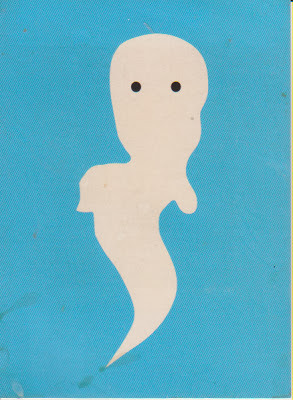
My wife Robin holds a grudge against the actress Kathy Najimy. I don’t, however. In fact, Kathy Najimy is part of one of the best memories of my marriage, but whenever I mention her, Robin scoffs. That’s how different our memories are of the event that caused it all. Nostalgic affection versus bitter resentment. It was summertime, and for Robin’s birthday we purchased tickets to the Hollywood Bowl’s Sound of Music Sing-a-Long for a large group of friends. The Hollywood Bowl is wonderful in the summer, and seems vast yet cozy. It holds more than 25,000 people, and when you are there on a summer night you feel like you are part of Los Angeles. You feel the pulse of the city, and know that besides a baseball game, nowhere else in L.A. are this many people gathering. It’s warm as the sun sets, but you have blankets ready for when the temperature drops. You are nestled snug in the hills, and if you’re high enough up you can see the illuminated Hollywood sign in the distance. The Hollywood Freeway cuts through the Cahuenga Pass to the East, and you can hear it like a distant river. Deer and coyote creep through the dark hills to the West. You may see them on your way back to your car after the show, if you tried street parking in the high neighborhoods. If you’re lucky the moon will be out, which makes Los Angeles seem perfect. The Sound of Music Sing-along is a hosted screening of the movie, The Sound of Music, and everyone is encouraged to dress up in costume. As the sun goes down there is also a costume contest, and then as night takes over they start the movie on a vast screen, with excellent subtitles. You sing with the songs, shout back at the picture, and they even hand out goodie bags of props to every attendee, so you can throw confetti in the air, hold up edelweiss as you sway and trade cards of your favorite things.
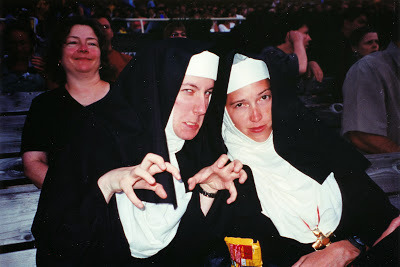
For the birthday party, we designed costumes for most of our friends. Do Re Mi Fa So La Ti and Do costumes were easy, for instance. We painted eight t-shirts with the two-letter word written on it, and then threw in an extra prop -- like tea bags hanging from a baseball cap for “Ti” for instance. We gave a plastic yellow sun hat to “Re,” a drop of golden sun. However, Robin went all out. After all, it was her birthday...and her undoing. Robin dressed as edelweiss -- head to toe. She designed a full body jump suit of lightweight astroturf, including a hood, and covered the entire suit with tiny white plastic flowers. She was a human carpet of the Austrian mountain flower. From the moment we arrived at the Bowl, she got compliments. Then she was spotted by some of the Bowl staff and invited to participate in the costume competition, hosted by the evening’s Master of Ceremonies, Kathy Najimy.
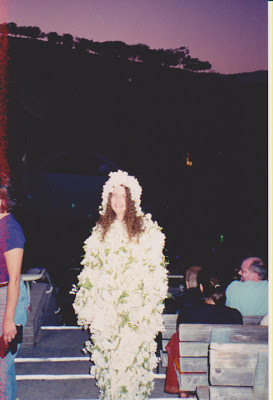
“Just head down to the stage and tell them that we picked you to compete,” one staffer explained. I escorted Robin down from Section K, high up in the nosebleed seats, but as we got to the stage, the guards told me I could not stand and wait in the aisle. I was a fire hazard, and my costume as the note “Do” was lame and clearly not worthy, so back to the nosebleed seats I went. I joined our party in Section K and watched as the sun set. It was timed perfectly. Kathy Najimy went through the line of costumed fans and either found a reason to eliminate them, or asked the crowd to vote. The house lights came on just as the semi final round started. The line of competitors, which started at twenty, was down to four, and Robin was surviving every cut. “She’s going to win,” I announced. Her birthday revelers shouted loud at every “scream if you like this one” vote, and soon everyone in Section K knew to shout for Edelweiss. Our fan base grew to surrounding sections, and I felt the power of ten thousand people in the upper seats deciding that Robin had to win. As the twilight faded, the lights of the Hollywood Bowl lit up behind the people on stage, and shifted in different pastel hues, illuminating the bandshell behind them. They lowered the big movie screen, and The Sound of Music logo came up in bright yellow. Robin survived the semi-finals. It was down to two costumes. Edelweiss Robin was up against two people who were dressed in ONE costume. They had taken a stretch of Astroturf, glued tiny hamlets, rocks, trees and rivers to it, and stuck their heads through two holes in the top. One would call out, ‘We’re the hills!” and the other would then chant, “and we’re alive!” Their presentation was good, but their costume was not. It came time for the final vote. Kathy Najimy said she would announce each costume, and then judge by the screams and applause. “And first up -- Edelwiess!” she yelled. Robin stepped forward, and opened her arms just as a spotlight hit her Center Stage. Her hundreds of white flowers lit up like a reflective beacon. It was dark by now, and my wife was a tiny speck on the most famous stage in Los Angeles, and 20,000 people were screaming for her. She was as big as Jay Z and bigger than Springsteen. She stood there, basking in the hot white light as thousands screamed for her. It was awesome, and I loved watching it.
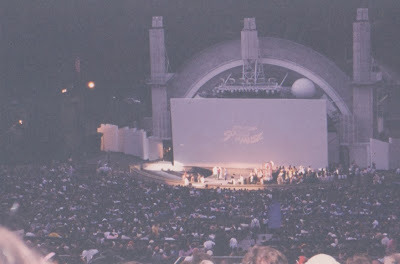
But Kathy Najimy made a mistake -- an understandable mistake, but a mistake for which Robin will never forgive her. In a music amphitheater so large there are several stations of speakers to amplify the noise as it goes back into the upper sections. It took an extra beat for Kathy’s question to make it all the way up to the back sections, and it then took a moment longer for the growing roar of the crowd to make it all the way back down to the stage, like a wave washing up and back through 20,000 people. But Kathy Najimy moved too quickly to the next contestant. “And who wants ‘The Hills?’” she asked, and Robin’s rivals benefitted from the roar that was still happening for her. Our roar, from way up in Section K,L,M,N, and O were hitting the stage just as Kathy switched to “The Hills.” She then decided, incorrectly, that “The Hills” had won. “The Hills” won a week-long cruise from Vancouver up through the Queen Charlotte Islands. Robin won second place, and received two free tickets to the Hollywood Bowl. The movie started. I saw Robin, the tiny dot, move off the stage and start the long losing trek up to the nosebleed seats. I ran down to meet her and got to her halfway and escorted her back. People were already yelling. “Edelweiss, you got ripped off!” “Edelweiss, you were the winner!” When we got back to our seats, I did a “shout-out” for Edelweiss and Sections K,L,M, N and O all screamed their support. It was awesome. The movie was great. The night was great. I was proud of Robin. I loved seeing my tiny little white dot down on the stage, her arms outstretched, as the screams of thousands rolled down the seats and across her. I loved being part of Los Angeles that night. All of that makes it a great memory for me. But Robin? When I told her I was writing this post, I asked her how she felt about that night. “Good times,” she said. “But I’m still a Bitter Betty.” I guess it’s like being proud of someone for winning a silver medal in the Olympics. I feel great for her, but she still remembers how close she was to gold...
Published on December 05, 2013 10:20
November 21, 2013
Gorneaux : Instagram Artist Douglas Gorney
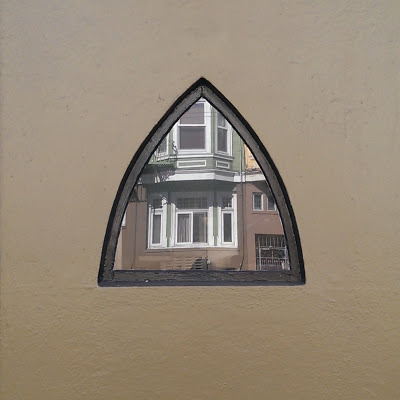
Douglas Gorney is a writer, editor, ghostwriter, Internet start-up entrepreneur, marketing consultant and serious photographer, and in the past year he’s become an Instagram artist, and his work is worth examining.
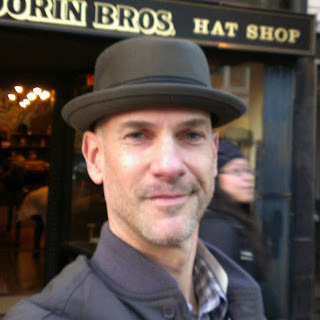
A few of his images are here on this post, but you can also go directly to: www.instagram.com/gorneauxto see more of his work. The thousand words here are like the restaurant review, while his site is where you can find the actual meal.

He lives in the Mission District of San Francisco, and as he exits his home every day he has his Android HTC smartphone with him, and a 2” by 2” frame in his head. He snaps photos of doors, gates, handles, rails, walls, windows, curbs, and garages. He likes the bright colors of the Mission, the twenty layers of paint on wood, stucco and metal, and he captures that interesting intersection where one piece of man made construction ends and the other begins.

We often race past these details around us without noticing, but Gorney sees them whenever he steps outside, and then captures them in that small square on his Android screen. He’s always looking, and he can easily spend two hours going only three blocks, while snapping dozens of photos. What’s worth framing today? If you’re wandering in the Mission, you may see him lying on the cement sidewalk, peering at a mail slot, or examining a stucco wall for five minutes, his nose two inches from the plaster. Gorney doesn’t feel hampered by the limits of 2” by 2” frame -- he feels it both challenging and freeing. And pulling out an Android or iPhone is easy. It’s a way of seeing, and serious photographers who embrace the smartphone and the smaller frame it provides gain speed, access, flexibility and freedom from it.
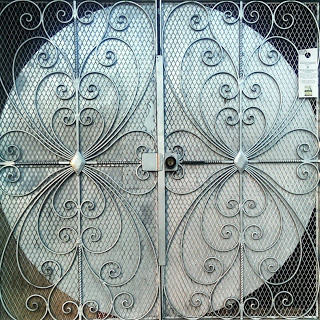
He’s engaged in urbex - urban exploration - but instead of crawling underground into the subway or climbing the outside of bridges, he goes “micro” and dives into the cracks of the city. Luckily, so far no one has confronted him, stepped on him, or opened a steel gate or window in his face. Once, at the Mission and 16th Street BART station however, an undercover SFPD police officer did grow suspicious and shadowed him for awhile. The officer let him off with a stern warning about drugs, which Gorney took in stride.

Gorney describes himself as a minimalist, and he has been invited to be part of RSA Minimal and RSA Doors and Windows, where his work is often featured. Most minimalist photography is true abstract art -- it exists on its own, separate from the time and place where it was captured. Even the objects themselves disappear as the frame defines a new two-dimensional beauty. The time and place where it was captured no longer matter, only the resulting “discovered” art does.

But what I like about Gorney’s work is that time and place still exist in all his photos, like a thick texture. Gorney admits that although he sometimes strives for that anonymous flatness of minimalism, you can’t help but feel the Mission District of San Francisco in his work. He loves what he calls the colorful grubbiness of his neighborhood, one of the oldest on the West Coast. Right now, the Mission is a mix of the original Hispanic neighborhood that flows with the street names -- MIssion, Valencia, Guerrero -- and the new hipster crowd who climb on Google commute buses that roll on those same streets. It’s a battle of gentrification, but this is still a place where it’s easier to add another spray of red stucco, another layer of pink paint, and another piece of blue trim rather than stripping it all bare and starting new. That would be like stripping away history, and it wouldn’t feel right.

The images he finds are thick with those years of paint, which seem to add thickness to the photo itself. I feel the neighborhood around the edges; I sense people are walking past, just a foot out of frame, and that someone will walk through just after he snaps the photo. He also goes through stages: "X" patterns, mail slots, small windows, numbers, then blues and now reds. On his page, you can see where he finished with one inspiration and then moved on to the next.
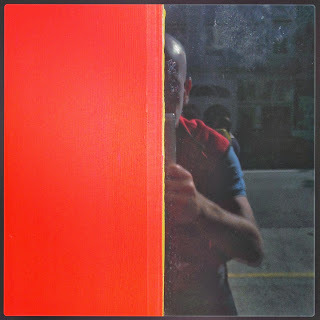
In terms of his work-flow, he used to feel compelled to take the photo and then instantly post, but now he’s slowing the process down. He collects images in the field, downloads them at home, and then tends to use the applications Pixl’r Express or Snapseed to reframe, crop, adjust color and saturation, and then carefully selects the ones worthy to post on-line.

He also feels his overall Instagram feed must have as much balance as each photo he creates. A photo is just one 2x2 shot that he fusses over, but the Instagram feed also shows his entire body of work, which he then must work on as well. The dozens of images flowing past must have the same balance as any individual photo, so the resulting whole is greater than the sum of its parts. It’s one of the quirks of Instagram, or any Internet feed -- as he adds to it, Gorney is forced to constantly analyze and edit a retrospective of his own work. Besides the RSA groups listed above that like him, Gorney recommends the Instagram groups Candy Minimal and Sundoors. He also likes MissUnderground, who is an urban explorer who snaps wonderful images of the London Tube. She has picked one formal theme -- the Tube -- and she never varies.
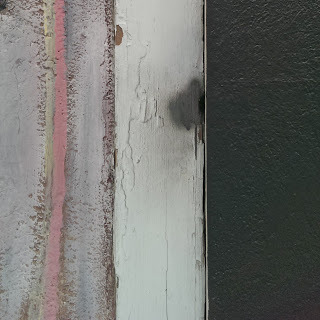
Calling all my cinematography, photography and fine artist friends! Let me know what you think of www.instagram/gorneauxand let’s get a dialogue going about his work, and then let’s discuss yours. I know you’re doing this too and that you have favorites of your own!
Published on November 21, 2013 10:32
November 14, 2013
A San Francisco Ghost Story
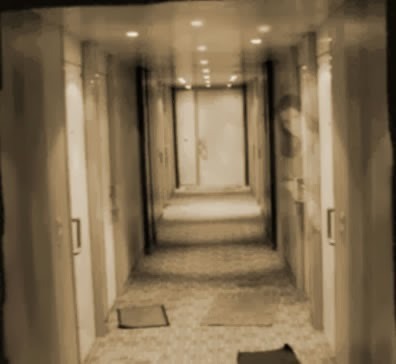
For a brief period of time, I lived in a house in San Francisco that had two ghosts who appeared late at night. I was haunted by one of these specters that frequented the attic, which had pitched walls and ran almost the entire length of the house, and was also my bedroom. There’s a famous photograph of a row of Victorian homes in San Francisco, The Painted Ladies, right on Alamo Square Park. The house I lived in is the old Victorian mansion on the corner of Steiner and Fulton Streets, but since the house hadn’t been gentrified yet, it never made it into any of those famous photos. The owner lived on the middle main floor, while she rented out the top two floors to Monica Stevens, who then rented out the four other bedrooms to a cadre of friends -- Steven Adams, Michael Ahearn, and others. The girl tenants would get the rooms on the main floor, while guys who rented got one of the two rooms one flight up, in the attic.

In your 20‘s you are on the move, cycling through jobs, school, traveling, and romances, so there was often a room on one of the floors open for rent. It was a carousel of young adults in their 20’s, coming and going, who were all part of an extended tribe. This was over twenty years ago, so rent was cheaper, especially by the room. I remember it was well under $1000 a month. Rent for any one-bedroom in San Francisco in any neighborhood is $3000 a month now, so I can’t imagine what rent for a Victorian on Alamo Square would be today. Back then, Hayes Valley was in transition, so there were hip restaurants and coffee shops, but car alarms were often going off after 9 p.m., and there was yelling in the streets.
The apartment itself was fun and funky. It had high ceilings with electric wall heaters, thick coats of paint on ancient molding, and long staircases that led up to small rooms with squeaky doors and loose doorknobs. When you walked in the front door you’d climb twenty steps to get to the first landing, where there was a plastered-over hole in the wall molding. There was once a wooden lever that filled that hole, and when you yanked on it, it pulled a metal band that would unlatch the locked door down below, so you didn’t have to walk down twenty steps to let someone in. I remember seeing those levers in old San Francisco homes when I was very young, but they’re gone now, and now the plastered over holes and the rusty mechanisms inside probably don’t even exist any more. But the ghosts were still there. And when they were in the world of the living, they probably yanked on the levers all the time to let in visitors and loved ones ringing the bell twenty steps below. Monica’s place had good parties, and cocktails on Friday afternoons before the fun began. The English Beat, and The Smiths were on the turntable. Yes, turntable. You get the idea. I had already moved to Los Angeles to attend film school, but I would return to San Francisco when I couldn’t find work, or because I couldn’t fully commit to life in Los Angeles yet, and I would end up living in the city again for three to four months at a stretch. Twice I got lucky and got a room at Chez Monica. For seven months I had the upper room on the East side of the building, overlooking downtown and the bay. It was a small room, but it had a big window and you could step outside on the roof and stare at the city, and even climb up on the pitched roof and read a book -- until the cold drove you back inside. During another brief time the attic room came available for rent. It was the largest room in the house, but it was not high in demand, because of the rumor that it was haunted. Both men who had lived in the room before me had encountered ghosts. Steven Adams lived in the room the longest, and was most plagued by the haunting. He recounted how there was a malevolent male spirit in the room who would throw books at him while he slept, and who would hold him down and try to suffocate him. I heard that Steven and Monica and others had once held a séance in the house, in an effort to appease the spirit, but I don’t think that it worked. There would sometimes be raucous parties in the house that went late into the night, with couples crouching in corners having heart-to-heart conversations, or people arguing politics in the kitchen over beer and cigarettes. It was after these parties that the other ghost would appear. Michael Ahearn, who also lived in the upper attic room for a while, said the floating image of an older man with gray hair and a beard would appear on the staircase or at the entrance to his room and block his way. The specter would stand there pointing and silently shouting, as if scolding him for his behavior. Therefore, I was excited when the attic room was free on my next rotation through the house. Both Steven and Michael casually warned me about the ghosts. I shouldn’t put books on the built-in bookshelf right under the window -- the ghost would knock them down on you. And leave the window open. The noises of the traffic would keep me awake and the room would get cold, but I’d have peace. The room had pitched sidewalls because of the roof, so there was no choice but to put your bed in the middle of the room and against the west wall of the house -- under the window. And right under the small window was the one shelf built into the wall.

I put books there, of course, and I waited. Nothing happened. Several weeks passed, and my room was warm and uneventful, and I forgot about all the stories. Then, one night, all six books landed on my head while I was sleeping. I assumed there had been an earthquake. Growing up in California, you know not to hang a painting or a mirror over your bed or headboard, and the same goes for books on a bookshelf, so I blamed myself ... until I found out there had been no quake. I put the books on the shelf again, and they were swept onto my head again the very next night. That’s when I felt the twinge. I started hearing creaks, and started to feel I wasn’t alone in the room at night. I stacked the books on the floor after that, and played my clock radio after sunset. Then the night came. I was sleeping and then had a dream that someone was sitting on my chest, until I realized I wasn’t dreaming. I was awake. I tried to sit up, but I couldn’t because the person then pushed me down even harder. I opened my eyes and saw nothing except the empty room, but I felt that someone was there. He was male, young, in his 20’s, around the same age as me, and he was enjoying crushing the air out of me. When he knew I was awake and scared he laughed, in fact, but I couldn’t hear it except in my mind. I tried to yell but couldn’t -- eventually I shook him off and he disappeared. I turned on all the lights and paced for a while, and then finally got back to sleep. From then on, I slept with the window open and I didn’t encounter the same problem again. I mentioned it to the other people in the house, and they confirmed that I had met the same ghost who bothered Steven so often, but for me it was only once. I’ve always loved ghost stories, so I did some research on the phenomenon, and it turns out that the haunting I experienced is the most common haunting there is. In fact, it’s so common there may even be a scientific explanation for it. Sleep paralysis is a phenomenon in which people, either when falling asleep or wakening, temporarily experience an inability to move. You are in between waking and sleep, usually disrupted REM sleep, which is when you dream. While sleeping, your body is smart enough to have muscle atonia, or muscle weakness, which is what prevents you from acting out your dreams. It’s a good thing we have it; otherwise we would all be sleepwalking every night. Sleepwalking, in fact, is when muscle atonia hasn’t kicked in, and people start wandering around while in REM sleep. The opposite is when muscle atonia lingers too long at the end of a dream, and that becomes sleep paralysis. You are waking up in the middle of a dream, before you have fully recovered your ability to move. Your dreaming brain is very good at creating imagery to explain outside stimulus, which is why when you are dreaming and someone shakes you, you often incorporate that shaking into your dream. You feel a tug on your arm, you look over and your brain creates an image from Star Trek, let’s say, of Spock grabbing your arm. Only after you emerge from REM sleep into wakefulness do you realize it’s your wife shaking you and not Leonard Nimoy. So what does your brain do when it’s still dreaming with protective muscle atonia, but then is suddenly awake? It creates a dream image to explain why it’s temporarily paralyzed, and we create an image in our brains of someone or something holding us down.
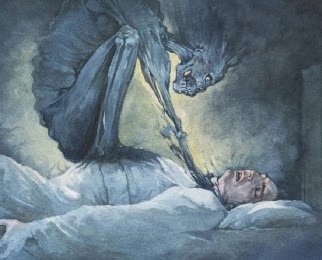
It’s so common that it’s called the “Old Hag Syndrome,” and people would say that “the old hag visited you” when you experienced this feeling. There are paintings and sculptures through the centuries of demons and monsters and hags sitting on people’s chests and paralyzing them in their sleep.

There are a lot of explanations to why you get sleep paralysis -- most of them having to do with difficulty sleeping or exhaustion, which is when your brain chemicals go wacky. Being active, sleep-deprived, alcohol-drinking men in our 20’s, this answers some questions about our mutual sleep paralysis, but not all. Why did Steven and I experience paralysis only in that room? Why did Steven experience it more often than me? Why did our brains create the same image, of a young angry man who was gleeful as he punished us? How does that explain the books falling on our heads? How does it explain the angry older man who would shout at Michael on party nights when he tried to bring girls upstairs? There have also been studies that show that many hauntings have been linked to a build-up of carbon dioxide in homes. When there is too much CO2, it’s poisonous and it can create hallucinations. In older homes it’s more common. Because heat rises, I speculate that that rising carbon dioxide rose with the warm air and collected in higher concentrations in the attic, the last room in the house. When you opened the window, the cold clean air would enter, and the noises would stop. This explains more -- perhaps that is why just one room was haunted in the house. At the same time there are still enough questions about my experience in the house to make me unsure about what really was going on. My next step in this investigation is to research, if possible, who lived in the house over the years. Perhaps an angry young man and a scolding older gentleman were previous tenants. I will keep you posted. If you have any thoughts or information, let me know!
Published on November 14, 2013 10:40



